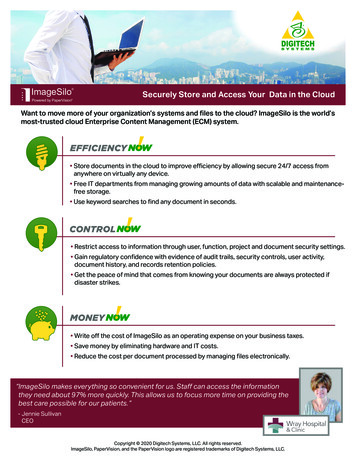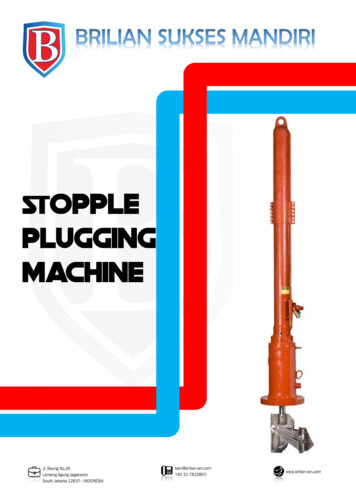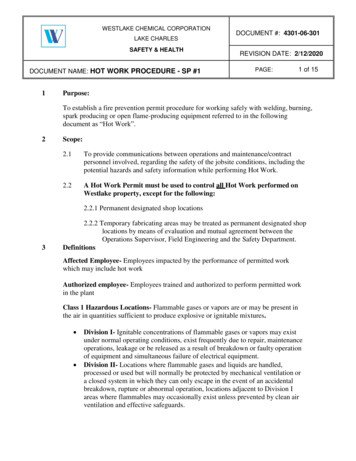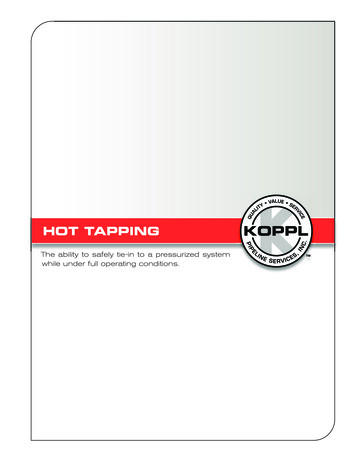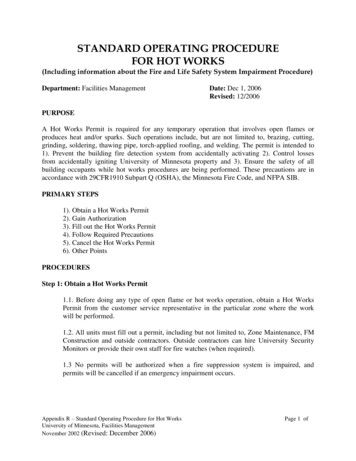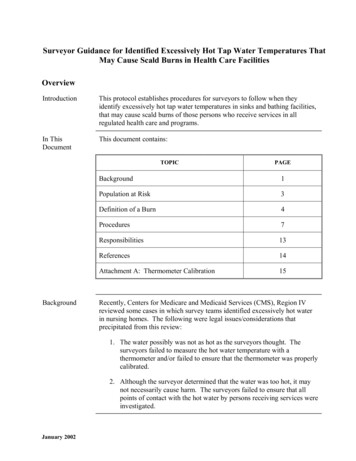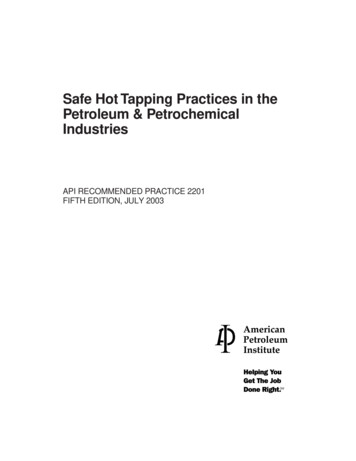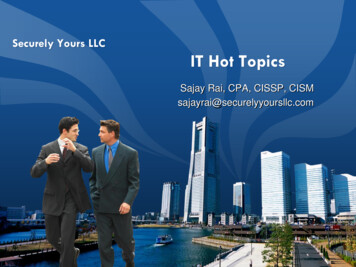
Transcription
Securely Yours LLCIT Hot TopicsSajay Rai, CPA, CISSP, CISMsajayrai@securelyyoursllc.com
ContentsBackgroundTop Security TopicsWhat auditors must know?What auditors must do?Next Steps[Image Info] www.wizdata.co.kr- Note to customers : This image has been licensed to be used within this PowerPoint template only. You may not extract the image for any other use.
BackgroundMovement towards Cloud More Applications in CloudMore Critical Data in CloudIntensity of Attacks C to C (Country to Country) C to C (Company to Company) C to C (Consumer to Consumer)Smart Devices Influx Critical data on Smart DevicesIncreased Data LeakageIncreased Regulations More scrutiny by Federal & State More demands by customers/clients
Top Security Topics1. Public Cloud
1. Public Cloud
1. Public CloudWhat is it? Organizations are starting to use public clouds for manycritical applications Sharing of folders e.g. Box.net Email e.g. Google mail Marketing and Sales e.g. Salesforce.com Organizations either access these applications in the cloud bycreating a separate account or link to their identity stores likeActive Directory or LDAP Organizations usually nominate an administrator within theirorganization to manage the users (addition, deletion andchanges)
1. Public Cloud
1. Public CloudWhat auditors must know? How the users within your organization access the application How are they authenticated? How the access to resources are provided? How the activities are logged and monitored? What data breach procedures does the service provider has? What access protocols does the service provider has in placeto prohibit their employees to look at your critical data? What Disaster Recovery and continuity procedures does theservice provider has? Does your organization use Single Sign-on (SSO) vendors inthe public cloud to make access easier to cloud applications(e.g. Ping Identity, OneLogin)? Does the organization have a right to audit the provider?
1. Public CloudWhat auditors must do?1.2.3.4.5.If using SSO vendors, verify that the passwords are not beingcopied or stored in the service provider systems. If they are, averification test should be performed that the passwords areencrypted (using appropriate encryption protocols) at all times.Verify that the appropriate documents are provided by cloudapplication providers (vulnerability scan reports, SOC2 type 2etc.)If possible, conduct periodic audits of the service provider (bigcompanies probably won’t let you conduct audits)Verify that your IAM process extends to the cloud serviceproviders as well (getting rid of ids when employee leaves)Verify that the logs are being reviewed either by serviceproviders or by your organization (monitor activity andanomalies)
Top Security Topics1. Public Cloud2. Smart Devices
2. Smart DevicesWhat is it? Proliferation of smart devices across the organization Started out as a replacement of blackberry but now major applications are being developedThe smart devices are starting to replace laptops andconnecting to the corporate networkMobile applications are being downloaded from Apple andGoogle stores at record paceIT has implemented Mobile Device Management (MDM)solutionsMajority of Internal Audit departments are now starting toinclude auditing of smart devices in their audit plans
2. Smart DevicesWhat auditors must know? MDM software allows to enforce security policies on thesmart device If your organization does not have an MDM software, thereare built-in features in Activesync which can be utilized E.g. Unlock, lock and wipe out devices Is confidential data residing on users smart devices Is your organization writing mobile apps and deploying onusers devices? Are smart devices connecting with corporate network toaccess internal folders and files? Understand the new features of operating systems which runthe smart devices
Security Features of iOS7
Single Sign-on Previously available for multiple apps developedby same developer (e.g. Google Apps) Now available for all Apps Some constraints: Kerberos enabled platform and application Still have to provision the device and sendprofile14
Restricting opening of attachments Restrict attachments to open within approvedapps (e.g. you can open an attachment incorporate email vs. personal email) Restricts data leakage Prevents users to take a picture of confidentialinformation and post it on facebook15
Default Data Protection When a passcode is configured, Apple used toprotect the data using hardware encryption, butit was left for developers to protect applicationdata (choice of encryption) Now, by default everything is encrypted16
Per App VPN Instead of a VPN for the IP address, now theVPN is per App. Different Apps can connect to different VPNs Not fully tested yet, but I think we would be ableto VPN to a payroll provider for payroll app anda bank for a banking application and both appscould be used interchangeably17
Activation Lock Currently, the Find My iPhone feature allows you to locateand secure your lost iOS device using the Find My iPhoneapp on another iPhone, iPad or iPod touch, or by visitingiCloud.com on your computer. Unfortunately, it has a major drawback. The thief can turn offyour iOS device and restore it to prevent you from using theFind My iPhone features. iOS 7 includes a new feature called Activation Lock. In iOS 7,turning off Find My iPhone or erasing your device requiresApple ID and password. It will also continue to display thecustom message displaying your contact number, even afteryour device is erased. This should make it a major deterrentfor thieves and make the Find My iPhone feature fool proof.18
iCloud Key Chain In iOS 7, Safari’s AutoFill feature has been extended toremember account names, passwords, and credit cardnumbers. Safari will automatically enter them when you visit asite to sign in or shop online. The keychain will also besynced via iCloud to all your iOS devices running iOS 7 andMacs running OS X Mavericks. Apple says the informationwill be stored using 256-bit AES encryption. Safari will also be able to generate a unique, hard-to-guesspassword like password management apps like 1Password. Unfortunately, this feature will be extremely useful only forusers who use Safari on their computers and iOS devices. Ifyou prefer using Chrome, then this feature is useless19
Private Browsing Easy to set private browsing on Safari Fingerprinting Two factor Authentication Still issues with it Hackers Ease of use Recent news of SIRI bug unlocking thephone20
2. Smart DevicesWhat auditors must do?1.Review the following documents: 2.3.4.5.Smart Device Use PolicySmart Device security PolicyIT Infrastructure architecture documentsMDM proceduresReports produced from MDMVerify that the security policy is implemented on the deviceVerify that the appropriate reports from MDM are beingreviewedVerify that appropriate authentication protocols are in place ifthe device is connecting to the corporate networkVerify that appropriate anti-virus scan is performed to downloadapps from stores and/or appropriate SDLC process is in place toreview the source code
Top Security Topics1. Public Cloud2. Smart Devices3. Cyber Insurance Policy
3. Cyber Insurance PolicyWhat is it? Designed to mitigate losses due to cyber incidentsVehicle to insure against cyber expensesSome policies cover regulatory penaltiesSome policies require minimum controls before the claims arepaid The positive is that it is a good tool to be part of your overallsecurity program and promotes security awareness The negative is that it is very expensive
3. Cyber Insurance PolicyWhat auditors must know? What is covered? What is not? What are the requirements of compliance?What auditors must do?1.2.3.Review the cyber security insurance policy as part of youroverall risk assurance programUnderstand the requirements of the policy for insurancecoverage and the state of security required to file claimCommunicate the requirements to security group
Top Security Topics1.2.3.4.Public CloudSmart DevicesCyber Insurance PolicyExtended Enterprise
4. Extended EnterpriseWhat is it? Service providers outside of your network Typically have access to OR store your confidential informationMay even have access to OR store HIPAA related or PIIinformationMay or may not have an agreement in placeMay or may not have a Business Associate AgreementMay provide the following services: Cloud (e.g. Salesforce.com)Backup and Recovery (e.g. Iron Mountain)Delivery (e.g. Fedex etc.)Smart devices (e.g. iCloud, apps which save your information in cloud) Potentially your weakest link
4. Extended EnterpriseWhat auditors must know? Identify third parties which provide KEY services The responsibilities of the service providers in terms of security Third party compliance with the contracted terms (includingBAA) What steps are taken before bringing in a new service provider(cloud, hosting etc.)What auditors must do?1.2.3.Identify the KEY service providersEnsure that the contracts with key service providers havesecurity requirements and if needed BAA agreementsReview the process of risk analysis for new service providers
Top Security Topics1.2.3.4.5.Public CloudSmart DevicesCyber Insurance PolicyExtended EnterpriseSecurity Information Event Management
5. SIEMWhat is it? Data Aggregation: Logs from various sourcesCorrelation: Looking for common attributesAlerts: Automated analysis and alertsRetention: Ability to retain past historyAutomate Compliance: by collecting compliance dataCommonly known software (Gartner top right Quadrant) HP’s ArcsightIBM’s Q1 LabsMcAfee (Nitro Security)Novell’s LogRhythm Other known software Splunk LogLogic Symantec and RSA
5. SIEMWhat auditors must know? What activity is going on? Are their risks which are being ignored or not known? What action is taken once an incident is reported ordiscovered? Is appropriate information recorded to understand theactivities taking place within the organization?What auditors must do?1.2.3.Understand the process of log management, logging, logreviewing and incident reportingIdentify the technologies whose logs are not reviewed orrecordedAre their correlation analysis done on the log data to identifyadvanced persistent threats
Top Security Topics1.2.3.4.5.6.Public CloudSmart DevicesCyber Insurance PolicyExtended EnterpriseSecurity Information Event ManagementData Leakage
6. Data LeakageWhat is it? Allows organization to understand the data which is cominginside the organization AND which data is leaving theorganization We want to know if unwanted data is coming in (e.g. malware) We want to know if confidential data is leaving (e.g. PHI or PII) DLP: assist with data leakage: Data Loss PreventionSymantecMcAfeeWebsenseRSA NGFW (Next Generation Firewall) Deep packet scanning Sees the content before it comes in Sees the content before it goes out
6. Data LeakageWhat auditors must know? What sensitive data is leaving the organization? In what form the data is leaving? What regulatory requirements does your organization have orwhat agreements you have with your clients (Encryption etc.) Focus on Data ClassificationWhat auditors must do?1.2.3.4.Review the process of data leaving the organization via differentvehicles: emails, Flash drives, FTP, website etc.Understand the technology implemented to assist with dataleakageVerify that regulatory or contractual requirements are metReview the data classification policy and procedures
Top Security Topics1.2.3.4.5.6.7.Public CloudSmart DevicesCyber Insurance PolicyExtended EnterpriseSecurity Information Event ManagementData LeakageAppropriate Access
7. Appropriate AccessWhat is it? Knowing the identitiesKnowing the rolesKnowing the accessReviewing the accessLogging the violationsTechnologies which can help: Work flowIdentity and Access ManagementPassword sync and password managementSingle Sign-onFederated Id
7. Appropriate AccessWhat auditors must know? Does sensitive data have appropriate access? Is Access to sensitive data reviewed by appropriate owners? Is Identity and Access managed appropriately within theorganization? Are sensitive data protected through a layered defense?What auditors must do?1.2.3.4.Ensure that the access review is performed periodicallyReview the provisioning and de-provisioning process foraccuracyReview how third party service providers get access to sensitivedataUnderstand how the system logs are reviewed and managed
Next StepsBird’s Eye View of AuditProperAccessMonitorActivityInsuretheRisks
Thank You!Sajay Rai 248-723-5224 sajayrai@securelyyoursllc.com
corporate email vs. personal email) Restricts data leakage Prevents users to take a picture of confidential information and post it on facebook 15 . Default Data Protection When a passcode is configured, Apple used to protect the data using hard
